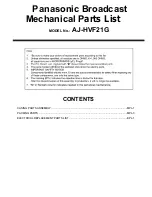
General Safety Rules (cont.)
Do not operate Trailer Valet while under the influence of drugs or alcohol. Read prescription
warning labels to determine if you may be impaired.
Stay Alert! Do not operate if you are tired.
As with all devices with moving parts, you should never wear clothing that is too loose, as it may
become caught, resulting in injury. Long hair should also be tied back and secured.
On inclines always keep tongue in downhill position.
Before each use of the Trailer Valet, check for damaged parts. Any part that appears to be
damaged should be carefully checked to determine if it will operate properly. Check for
alignment and secure mounting of all moving parts. If not aligned and/or secured, DO NOT use
Trailer Valet. It is recommended that the trailer be restricted with wheel blocks or attached to a
vehicle until it can be properly repaired or replaced by a qualified technician.
When servicing, use only identical replacement parts.
Assembly of Trailer Valet
Before assembling your Trailer Valet, double check that you have all the parts and tools you’ll need.
Included in the box:
1 -- assembled Trailer Valet
8 -- lock washers
1 -- drive handle (part #4)
8 -- washers
1 -- mounting bracket (part #20)
4 -- bolts and nuts
2 -- trailer mount clamp (part #21)
1 -- stow pin (part #22)
1 -- rotation pin (part #23)
1 -- cotter pin (part #22)
1 -- owner’s manual
Tools that you will need:
2 -- crescent wrench
1. The Trailer Valet is only to be installed on trailer tongues that are rectangular in profile.
Cylindrical tongues are not compatible with the Trailer Valet as it will rotate, allowing the trailer
to drop.
2. The safest way to install the Trailer Valet is while the trailer is securely mounted to your vehicle.
3. When choosing a location for the mounting clamp, choose a location where the Trailer Valet will
be able to freely rotate from its vertical operation position to its horizontal stow position.
4. The mounting clamp has 7 holes to fit a variety of trailer frames, additionally the mounting
clamp has two positions you can mount it at depending on the height of your trailer. On trailers
which have more ground clearance, placing the mounting clamp’s cuff lower will minimize the
amount of jacking needed to raise and lower the tires. See illustration at the end of this section
on the next page.
Assembly of Trailer Valet continued on next page
Page 3


























